Home >Web Front-end >HTML Tutorial >Advantages and Challenges of Responsive Layout on Mobile Devices
Advantages and Challenges of Responsive Layout on Mobile Devices
- 王林Original
- 2024-01-27 10:06:071318browse

The advantages and challenges of responsive layout on mobile devices
With the popularity of mobile devices, more and more users use mobile phones and tablets to browse the Internet . This forces website developers to consider operation and display issues on mobile devices. And responsive layout emerged as one of the most popular and effective solutions. Responsive layout allows a website to adjust its layout and element size according to the user's device size and screen resolution, providing the best visual experience on different devices. However, in practice, responsive layouts face some advantages and challenges.
First of all, one of the advantages of responsive layout is that it provides a consistent user experience. Users can access the same website from different devices without having to develop separate versions specifically for each device. Whether users access the site on a mobile phone, tablet, or traditional desktop computer, they have access to the same content and layout. This consistency helps build brand image and user loyalty.
Secondly, responsive layout has good maintainability. Rather than maintaining multiple device-specific versions of your website, a responsive website only needs to be modified once to adapt to different devices and screen sizes. In this way, developers only need to focus on one version and can maintain and update code more efficiently.
In addition, responsive layout also helps improve search engine optimization (SEO) results. As mobile device users increase, search engines give higher ranking weight to mobile-friendly websites. A responsive website provides consistent content and link structure, making it easier for search engines to recognize and index the website's content, thereby increasing the website's visibility in search results.
Although responsive layout has many advantages, it also faces some challenges. First of all, responsive layout needs to consider and handle the adaptability of multiple devices. Due to differences in screen sizes and resolutions, developers need to design and optimize layouts to accommodate display on various devices. This requires more time and effort to test and adjust to ensure the website displays and operates correctly on a variety of devices.
Secondly, responsive layout may have performance issues. Mobile devices often have limited processing power and bandwidth, so loading a large number of resources and elements can cause pages to load slowly. In order to reduce page load time, developers need to optimize the website, including operations such as compressing images, lazy loading, and caching, to improve page performance and user experience.
Finally, responsive layout is also a challenge for designers. Due to the smaller screens of mobile phones and tablets, designers need to layout and display content reasonably within limited space. This requires designers to have good creative and layout skills to ensure that the website can provide a good user experience on different devices.
To sum up, responsive layout has many advantages on mobile devices, including consistent user experience, good maintainability and better SEO results. However, it also faces fit, performance, and design challenges. Through reasonable design and optimization, responsive layout can help developers provide the best user experience on mobile devices and adapt to the needs of the growing mobile device user base.
The above is the detailed content of Advantages and Challenges of Responsive Layout on Mobile Devices. For more information, please follow other related articles on the PHP Chinese website!

